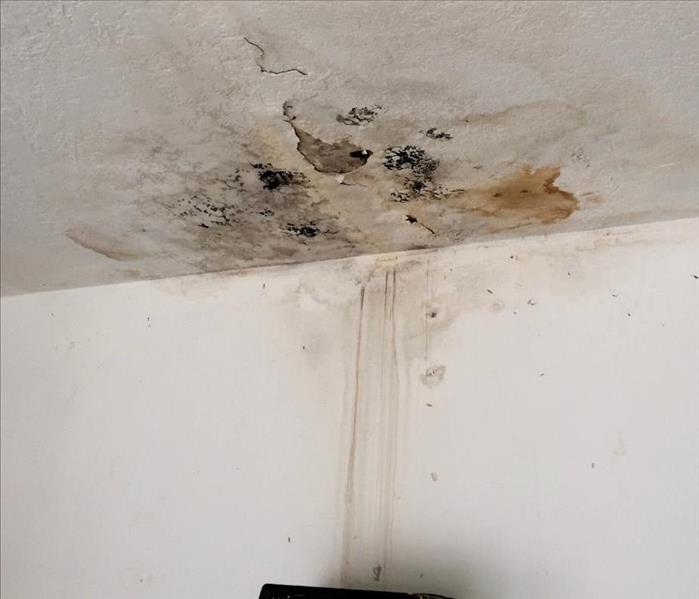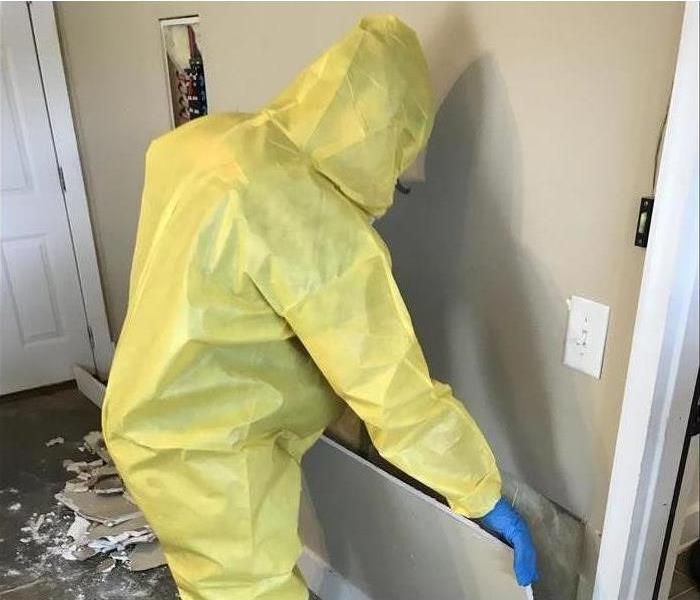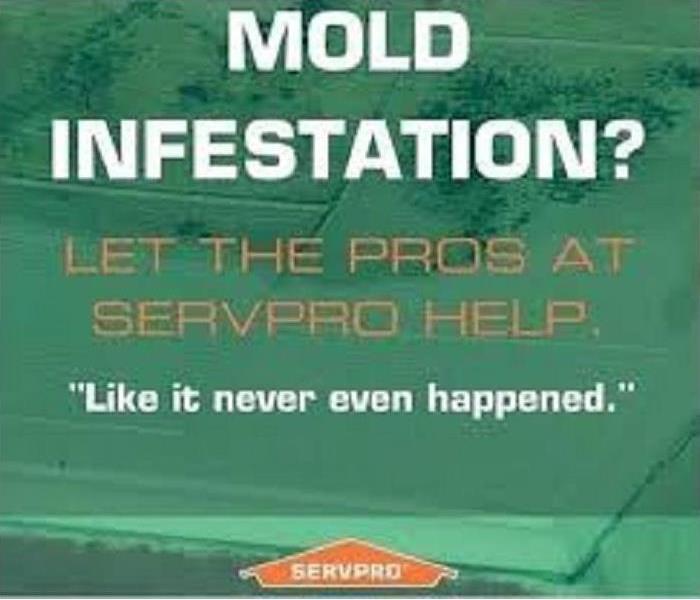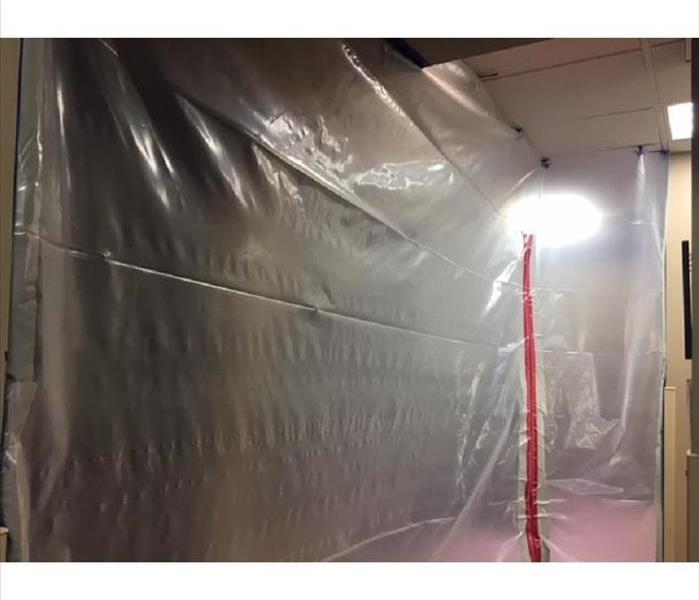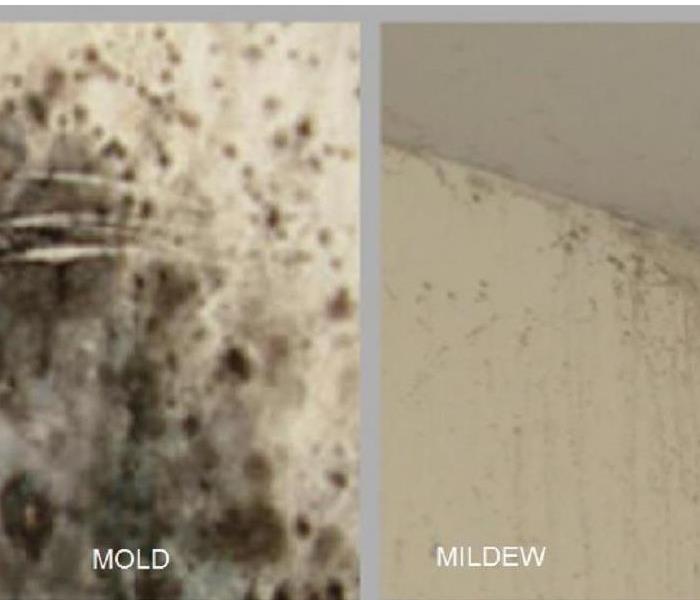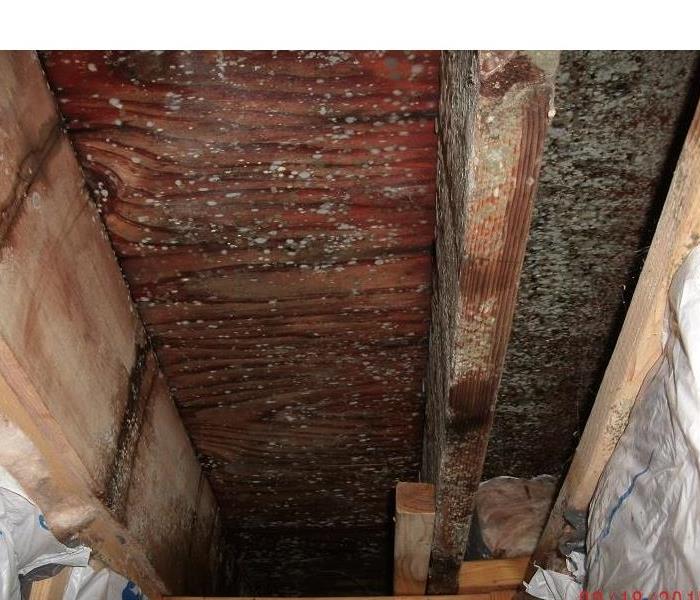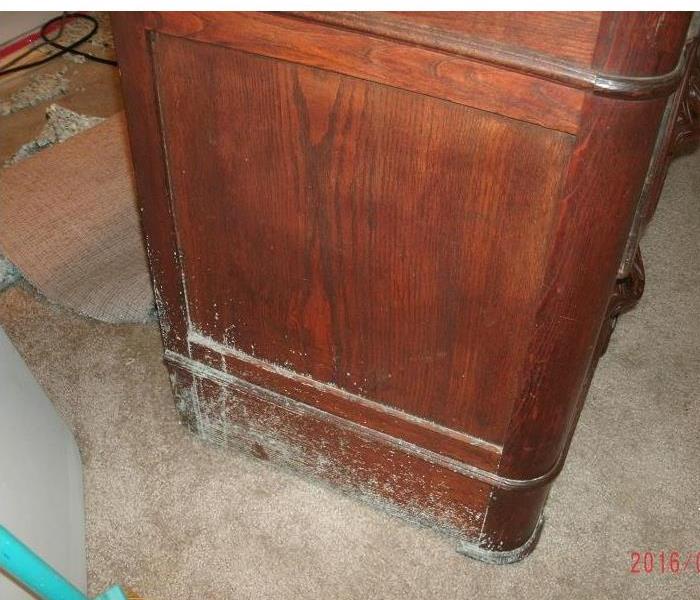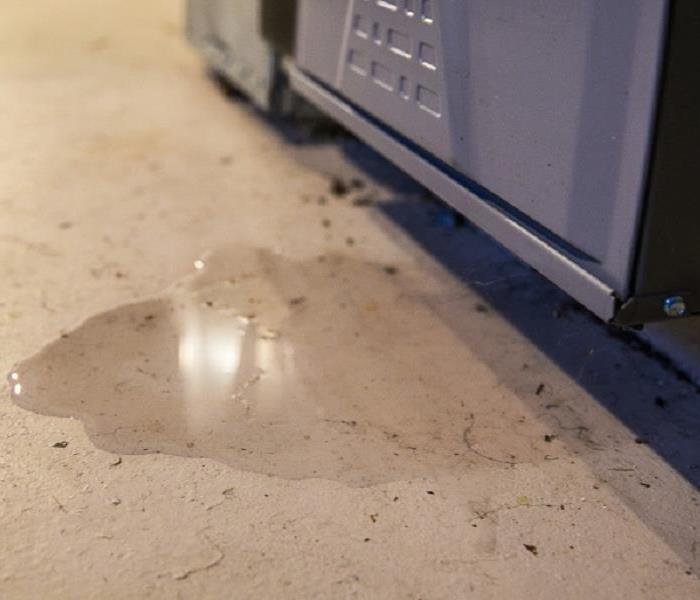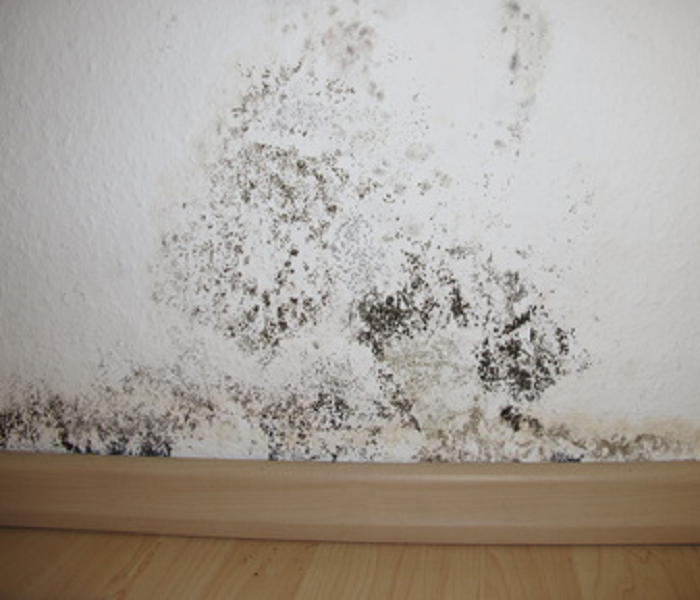Recent Mold Remediation Posts
Removing Mold: Trusted Mold Remediation Specialists in Lincoln, NE
4/1/2024 (Permalink)
Mold growth can pose serious health risks and compromise the integrity of your property, but at SERVPRO of Lincoln, serving the Lincoln, NE area, we're here to help you reclaim a safe and healthy environment.
- Thorough Inspection: Our certified technicians conduct a comprehensive inspection to identify mold colonies and assess the extent of the infestation.
- Safe Remediation: Using industry-leading techniques, we safely remove mold and prevent further spread, ensuring a thorough and effective remediation process.
- Prevention Strategies: We provide expert recommendations and solutions to address moisture issues and prevent future mold growth, safeguarding your property from recurring infestations.
Trust SERVPRO of Lincoln to provide reliable and effective mold remediation services in Lincoln, NE. Contact us today and take your space back from mold.
The Process of Mold Remediation
10/12/2021 (Permalink)
What’s the Difference?
Since microscopic mold spores exist naturally almost everywhere, indoors and outdoors, removing all mold from a home or business is impossible. Some restoration businesses advertise “mold removal” and even guarantee to remove all mold. This is a fallacy.
A qualified restoration company understands the science behind mold and mold growth. SERVPRO of Lincoln Professionals have the training and expertise to remediate the mold in your home or business. Mold remediation focuses on getting mold levels back to normal, natural levels.
Every mold damage scenario is different and requires a unique solution, but the general mold remediation process stays the same. To learn more about our mold remediation process.
- Step 1: Emergency Contact 402-466-4004
- Step 2: Inspection and Mold Damage Assessment
- Step 3: Mold Containment
- Step 4: Air Filtration
- Step 5: Removing Mold and Mold-Infested Materials
- Step 6: Cleaning Contents and Belongings
- Step 7: Restoration
Signs of Mold? Call Today 402-466-4004
Understanding Mold
When water intrudes into your property, mold growth can start in as little as 48 hours. Consider the following mold facts:
- Mold is present almost everywhere, indoors and outdoors.
- Mold spores are microscopic, float along in the air, and may enter your home through windows, doors, or AC/heating systems or even hitch a ride indoors on your clothing or a pet.
- Mold spores thrive on moisture. Mold spores can quickly grow into colonies when exposed to water. These colonies may produce allergens and irritants and have the potential to cause other health effects.
- Before mold remediation can begin, any sources of water or moisture must be addressed. Otherwise, the mold may return.
- Mold often produces a strong, musty odor, and that odor can lead you to possible mold problem areas.
- Even higher-than-normal indoor humidity can support mold growth. Keep indoor humidity below 45 percent.
Can Your Belongings Recover From Mold Growth?
10/26/2020 (Permalink)
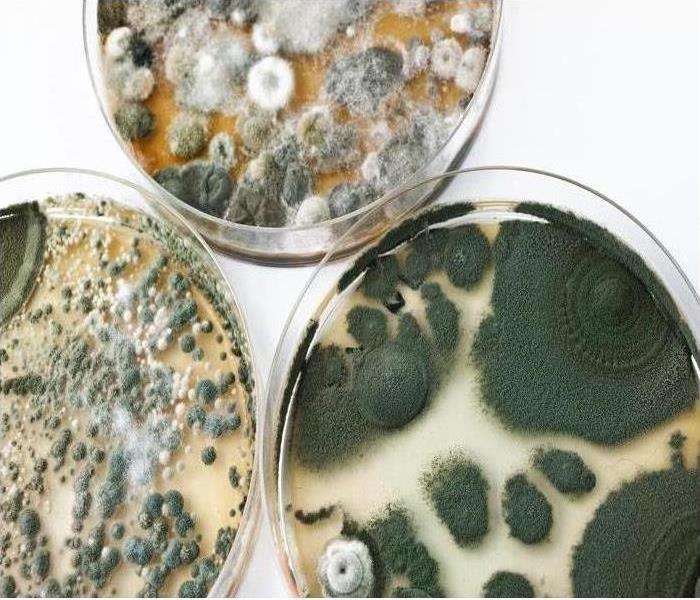 Mold Growth
Mold Growth
How To Recover From Mold Growth?
Moisture and high humidity can attract mold spores into your home, where they can grow across a variety of surfaces. While mold commonly grows on building surfaces like drywall and carpeting, it can also affect your belongings, such as clothing and furniture. Mold cleaning can be difficult; however, before you throw items away, you may want to learn about which could be saved by different types of professional cleansing processes and which cannot.
1. Throw Away Porous Items
Most porous surfaces can absorb water and encourage further mold growth. As such, some items like mattresses, thick rugs and stuffed toys that already show signs of mold damage are usually not salvageable. If your child has a favorite stuffed toy that you want to attempt to save, ask your remediation technicians if they have any mold cleaning processes that may help. You may want to remember, however, that porous items affected by black mold are usually considered unsalvageable because this type of fungus is particularly hard to eradicate.
2. Freeze Documents and Books
If you have important documents and books that developed mold, place them in sealable plastic bags and store them in your freezer. Freezing these items can inhibit further mold growth and protect them until they can be inspected by an expert mold remediation and restoration company. This can salvage items like original birth certificates, wedding albums and baby books.
3. Set Aside Moldy Clothing
If you have favorite items of clothing that have been affected by mold, ask your remediation technicians about what type of options you have for salvaging them. Wet, dry and immersion cleaning may all be possible, especially for leather jackets and shoes. Some companies have access to an Esporta Machine, which cleans soft contents by removing tough odors, dirt and mold in a way that even commercial-grade units cannot.
Mold can have a devastating effect on your home’s contents. However, professional mold cleaning processes may be able to salvage your treasured possessions, even if you believe they are beyond repair.
Mold's #1 Enemy
2/5/2019 (Permalink)
Mold is no match for SERVPRO of Lincoln, we have been its number 1 enemy. Our team of dedicated professionals who have years of experience in the industry use advanced water detection equipment to locate the source of the problem. Saving you time and money as we remediate any mold or water damage from losses like a dishwasher leak, pipe break, sprinkler head malfunction, toilet overflow or your washing machine that is on the second floor and was a huge selling point when you bought but now is your least favorite part of your home. Our team of technicians help walk with you through the process of having a disaster happen in your home or office, through speaking with insurance and supplying them with the documentation that they need to complete the claim process. We empower you to make decisions that are right for you, your family or business. We have been helping customers like you make it “Like it never even happened.”
SERVPRO of Lincoln specializes in the cleanup and restoration of residential and commercial property after a fire, smoke or water damage event. We can handle any size disaster!
Call us at (402) 466-4004
Indoor Air Quality in Lincoln NE
12/18/2018 (Permalink)
Indoor air quality/environmental professionals evaluate the quality of the air inside a structure. Some specialize and are skilled in testing buildings for the presence of molds. Using various testing devices, these professionals collect air and surface samples to compare the indoor mold spore count to the outdoor environment. If you have concerns about mold, SERVPRO of Lincoln can assist you in locating a qualified indoor air quality/environmental professional.
SERVPRO of Lincoln cares about proper restoration of your structure. In most water damage situations excessive mold growth is not a problem and SERVPRO of Lincoln can safely restore your building to preloss condition. The need to address the presence of mold can be determined by an on-site, indoor environmental inspection.
SERVPRO of Lincoln specializes in the cleanup and restoration of residential and commercial property after a fire, smoke or water damage event; as well as mold remediation. We can handle any size disaster!
Call us today at 402.466.4004
3 Items That Can Be Salvaged After Mold Damage
12/18/2018 (Permalink)
Mold growth can be a common result of flooding in your Lincoln, NE, home. Mold can grow on a variety of items, from furniture to walls to wood and flooring. When it comes to mold cleaning, however, you may be surprised about the number of objects that can be salvaged when you know the steps for cleaning them properly.
1. Leather Goods
Leather bags, jackets and other items may be salvageable if you remove them from the affected area quickly. Because mold tends to spread faster in areas with high humidity, you can perform mold remediation for these items by transferring them to a room that is cool and dry. Once the leather has dried, you can sponge the surface with diluted baby soap to wipe away visible mold. Suede goods may need to be treated by a mold cleanup and restoration company.
2. Clothing
While not all clothing can recover from mold damage, you may be able to salvage some items. An Esporta Machine, which is designed to clean cotton clothing affected by mold, smoke and other substances, can be effective in removing mold. You may be able to soak some fabrics in diluted vinegar to remove the mold, but this depends on how fragile the fabric is. Your restoration experts may able to advise you about other mold cleaning processes.
3. Paintings
Paintings affected by mold require special treatment. You may want to remove any wooden framing, as mold is attracted by wood fibers. Store the painting flat, away from humidity and sunlight, before contacting a professional artwork restoration company. Avoid bagging or sealing it in any kind of tight container, as this may create humid conditions that could encourage further mold growth.
When flooding in Lincoln, NE, causes mold to grow on your belongings, you may not know where to begin with mold cleaning. Contacting professional restoration technicians and removing your items from areas where mold is present can help you salvage irreplaceable items and proceed with the rest of the cleanup with confidence.
SERVPRO of Lincoln specializes in the cleanup and restoration of residential and commercial property after a fire, smoke or water damage event; as well as mold remediation. We can handle any size disaster!
Call us today at 402.466.4004
How Can You Control Mold Growth?
8/27/2018 (Permalink)
Moisture Control is Key to Mold Control
- Keep humidity levels as low as you can—no higher than 50%--all day long. An air conditioner or dehumidifier will help you keep the level low. Humidity levels change throughout the day as changes occur in the moisture in the air and the air temperature, so check the humidity levels more than once a day.
- If you see condensation or moisture collecting on windows, walls or pipes ACT QUICKLY to dry the wet surface and reduce the moisture/water source. Condensation can be a sign of high humidity.
- Be sure your home has enough ventilation. Use exhaust fans, which vent outside your home in the kitchen and bathroom. Make sure your clothes dryer vents outside your home.
- Fix any leaks in your home’s roof, walls, or plumbing so mold does not have moisture to grow.
- Clean up and dry out your home thoroughly and quickly (within 24–48 hours) after flooding.
- Remove or replace carpets and upholstery that have been soaked and cannot be dried promptly. Consider not using carpet in rooms or areas like bathrooms or basements that may have a lot of moisture.
Call SERVPRO of Lincoln at 402-466-4004 to remediate your mold growth.
Understanding The Mold Remediation Process
8/27/2018 (Permalink)
Every mold damage scenario is different and requires a unique solution, but the general mold remediation process stays the same. The steps listed below illustrate the “typical” process:
Step 1: Contact SERVPRO of Lincoln 402-466-4004
The mold cleanup and restoration process begins when you call our office. Our office will ask a series of questions to help us determine the necessary equipment, resources, and personnel.
Step 2: Inspection and Mold Damage Assessment
SERVPRO of Lincoln will carefully inspect your property for visible signs of mold.
Step 3: Mold Containment
SERVPRO Technicians use various containment procedures to prevent the spread of mold. They may use advanced containment procedures like negative air chambers to isolate the contaminated area with physical barriers and negative air pressure to keep the mold spores from spreading during the cleanup process. All fans and heating and cooling systems will be turned off to prevent the spread of mold.
Step 4: Air Filtration
Their specialized filtration equipment allows our Professionals to capture microscopic mold spores out of the air. We utilize powerful “air scrubbers” and HEPA vacuums to prevent the spread of these mold spores while the mold remediation is in process.
Step 5: Removing Mold and Mold-Infested Materials
The mold remediation process depends on the amount of mold growth and the types of surfaces on which the mold appears. SERVPRO of Lincoln uses antifungal and antimicrobial treatments to eliminate mold colonies and to help prevent new colonies from forming. Removing and disposing of mold-infested porous materials, like drywall and carpeting, may be necessary to remediate heavy mold growth.
Step 6: Cleaning Contents and Belongings
SERVPRO will clean your furniture, decorative items, curtains, clothing, and other restorable items affected by mold. We use a variety of cleaning techniques to clean and sanitize your belongings. We are also trained to remove odors and deodorization using fogging equipment.
Step 7: Restoration
Depending on the level of mold damage, drywall, subfloors, and other building materials may be removed. Restoration may involve minor repairs, such as replacing drywall, painting, and installing new carpet; or it may entail major repairs such as the reconstruction of various areas or rooms in a home or business.
Understanding The Mold Remediation Process
8/27/2018 (Permalink)
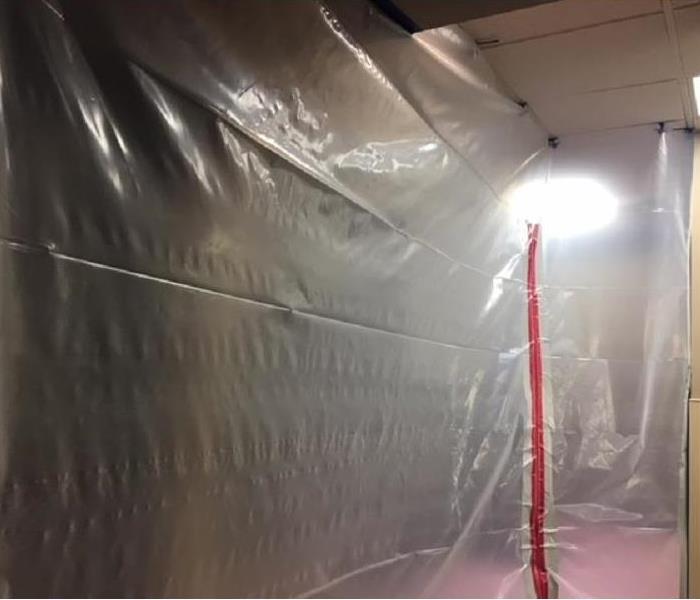 A good containment will protect the surroundings from mold spores spreading.
A good containment will protect the surroundings from mold spores spreading.
Every mold damage scenario is different and requires a unique solution, but the general mold remediation process stays the same. The steps listed below illustrate the “typical” process:
Step 1: Contact SERVPRO of Lincoln 402-466-4004
The mold cleanup and restoration process begins when you call our office. Our office will ask a series of questions to help us determine the necessary equipment, resources, and personnel.
Step 2: Inspection and Mold Damage Assessment
SERVPRO of Lincoln will carefully inspect your property for visible signs of mold.
Step 3: Mold Containment
SERVPRO Technicians use various containment procedures to prevent the spread of mold. They may use advanced containment procedures like negative air chambers to isolate the contaminated area with physical barriers and negative air pressure to keep the mold spores from spreading during the cleanup process. All fans and heating and cooling systems will be turned off to prevent the spread of mold.
Step 4: Air Filtration
Their specialized filtration equipment allows our Professionals to capture microscopic mold spores out of the air. We utilize powerful “air scrubbers” and HEPA vacuums to prevent the spread of these mold spores while the mold remediation is in process.
Step 5: Removing Mold and Mold-Infested Materials
The mold remediation process depends on the amount of mold growth and the types of surfaces on which the mold appears. SERVPRO of Lincoln uses antifungal and antimicrobial treatments to eliminate mold colonies and to help prevent new colonies from forming. Removing and disposing of mold-infested porous materials, like drywall and carpeting, may be necessary to remediate heavy mold growth.
Step 6: Cleaning Contents and Belongings
SERVPRO will clean your furniture, decorative items, curtains, clothing, and other restorable items affected by mold. We use a variety of cleaning techniques to clean and sanitize your belongings. We are also trained to remove odors and deodorization using fogging equipment.
Step 7: Restoration
Depending on the level of mold damage, drywall, subfloors, and other building materials may be removed. Restoration may involve minor repairs, such as replacing drywall, painting, and installing new carpet; or it may entail major repairs such as the reconstruction of various areas or rooms in a home or business.
Is It Mold Or Mildew?
3/2/2018 (Permalink)
Is It Mildew Or Mold?
Plain and simple, mildew and mold are fungi. Fungi can live in many different types of habitats such as in soil, on vegetation, and on surfaces exposed to moist conditions like a wall or ceiling after flood damage. Fungi reproduce by spores and quickly can spread.
What is mildew? Mildew is mold in its early stage and often the term is used interchangeably with the word mold. That whitish-gray, powdery substance sometimes seen on the leaves of a plant is mildew. Mildew is a surface fungi that grows on organic material like plants and food as well as wood or fibrous items like:
- Drywall
- Insulation
- Cardboard/paperboard
- Wallpaper
- Fabric
How is it different from Mold? Mold ranges in color from green to gray, brownish and black. It may appear fuzzy, flat or even slimy. Green slimy mold may develop in the damp, shady areas of decks and even vinyl siding, while indoors, mold can develop on grout, tile and other surfaces found in and around bathrooms and other areas with high humidity and inadequate ventilation.
Differences in the Effects of Mold and Mildew
Both mold and mildew need to be taken care of in a quick and efficient manner as they can cause a lot of trouble over time:
- Mildewusually affects plants and crops.
- Mold can result in considerable structural damage when left unattended for a long time.
What is Mold and how many types are there?
Although the number of mold species that can live indoors exceeds 10,000, the most household molds belong to one of the following five types:
- Alternaria grows on walls, in showers, around windows, under sinks and in various other damp places.
- Aspergillus is the most common type of mold found indoors. It can look grey, brown, yellow, green, white, or black. Aspergillus mold usually grows on walls, insulation, paper products, and clothing.
- Cladosporium can grow in cool areas. It usually appears on fabrics, such as carpets or curtains, and on wood surfaces, like cabinets and floorboards.
- Penicillium can be found on various materials that have been in contact with water, including carpeting, wallpaper, insulation, and mattresses. It looks blue or green and produces strong musty odors.
- Stachybotrys chartarum, often referred to as “black mold” because of its color, is the most dangerous kind of household mold.
How to Prevent Mold and Mildew
The most efficient way to prevent mold and mildew in your home is to keep all the areas dry and moisture-free. Maintain a humidity level of about 40-50% inside the house (a dehumidifier provides the most advantageous solution for ensuring appropriate indoor humidity), have your heating and cooling systems regularly inspected, keep air ducts clean and in good condition, ensure good air circulation inside the premises, fix any leaks in the bathroom, kitchen or other areas, etc. Remove any mildew-affected plants and weeds as soon as you notice them in order to prevent mildew infestation.
How to Clean Mold and Mildew
Mildew is a surface fungus that can be efficiently treated with a commercially available cleaner and a scrubbing brush. Just make sure you work in a well-ventilated area and wear a facial mask to prevent inhaling mildew spores, as well as to avoid breathing in fumes given off by the cleaning product you use. It is also advisable to put on rubber gloves in order to protect your hands both from the mildew and from the cleaning agent. Clean all the surrounding areas carefully as well, to ensure that all the fungi have been successfully removed.
Mold, on the other hand, attaches to the affected materials with microscopic filaments that penetrate beneath the surface. The mold spores spread very easily and can survive in extreme conditions, so they can quickly affect large areas of your property and result in permanent damage. Despite its characteristic musty smell, mold is only visible to the eye when the colonies start growing, so early detection and prevention is very difficult. DIY remedies are rarely efficient because the fungus usually grows in areas that are very difficult to access and to treat
The Need for Mold Remediation
Mold and mildew, if ignored, can cause long-term health issues and physical damage to a home or business. Mold found anywhere in a building, such as behind drywall, on insulation, around windows and along basement walls has developed because there is a moisture problem. To avoid further damage, it’s essential to locate and correct the source of the moisture and then remove all traces of mold. The safest and most efficient way to get rid of a mold problem is to call a mold remediation company. An experienced professional will come to your home to assess the situation and determine the type of mold or mildew in your property, as well as the extent of the damage. Then, the most appropriate actions will be taken to remove the harmful fungi and prevent its appearance in the near future. The experts will help ensure not only the safety of your living environment, but also your peace of mind.
How To Be Safe If You Suspect Mold In Your Bennet Home
12/21/2017 (Permalink)
Bennet, Nebraska residents, follow these mold safety tips if you suspect mold.
If you see visible mold, do not disturb it. You can inadvertently spread the mold infestation throughout your home. When mold is disturbed, the mold can release microscopic mold spores which become airborne and can circulate inside your home.
What to Do:
- Stay out of affected areas.
- Turn off the HVAC system and fans.
- Contact SERVPRO of Lincoln for mold remediation services.
What Not to Do:
- Don’t touch or disturb the mold.
- Don’t blow air across any surfaces with visible or suspected mold growth.
- Don’t attempt to dry the area yourself.
- Don’t spray bleach or other disinfectants on the mold.
About Our Mold Remediation Services
SERVPRO of Lincoln specializes in mold cleanup and restoration, in fact, it’s a cornerstone of our business. Our crews are highly trained restoration professionals that use specialized equipment and techniques to properly remediate your mold problem quickly and safely.
If You See Signs of Mold, Call Us Today – 402-466-400
Mold Removal Frequently Asked Questions
12/21/2017 (Permalink)
Mold Removal FAQ
It is well known that mold and the process of mold removal can be dangerous. However, not many people are knowledgeable about the issue. Mold does not spontaneously develop; it is caused by other problems in homes, such as high humidity levels or excess water.
Additionally, only a physician has the qualifications to determine if someone's health is at risk. People have different tolerance levels, though certain people are at higher risk. The following are a few FAQs with potentially helpful answers.
Is it Necessary to Test My Home for Mold?
You can determine your need for mold removal using different factors, such as visible mold, musty odors, and health issues with inexplicable symptoms. If any of these are observed, a Certified Indoor Environmentalist or Industrial Hygienist should be contacted for testing. You can visit www.iaqa.org or use the search engine of your choice to find a local Indoor Air Quality expert.
Is there a spray that I can use to kill mold myself?
As earlier stated, there are particular conditions that foster mold growth; if these are not remediated, mold will keep growing or reappear. There are topical sprays that are capable of helping to eradicate mold, but an untrained individual should not use them without the appropriate training and equipment. Some contractors will use spray; as long as they have the training to know that it will be effective and permanent, this should work. However, spray can leave stains that will be indicative of a past mold problem, which could make it difficult to sell the home if you plan to do so.
What Are Molds and Where Do They Grow?
10/16/2017 (Permalink)
What are molds and where do they grow?
Molds, like most fungi, break down plant and animal matter in the environment. They can grow almost anywhere there is moisture and organic material such as in soil, on foods and plants, and in people's homes. To reproduce, molds release spores, which can spread through air, water, or on animals.
What should I do to prevent mold growth in my Lincoln Nebraska home?
The key to preventing mold growth is to identify and control moisture and water problems. Mold spores are everywhere, including your home, and they can grow on any surface that has sufficient moisture.
Common sources of moisture are:
- Roof leaks
- Indoor plumbing leaks
- Outdoor drainage problems
- Damp basements and crawl spaces
- Steam from the bathroom or kitchen
- Condensation on cool surfaces
- Humidifiers
- Wet clothes drying inside the home
- A clothes dryer venting indoors
- Poor or improper ventilation of heating and cooking appliances
- Flooding
How do I know if I have a mold problem?
You can usually see or smell a mold problem. Mold can appear as slightly fuzzy, discolored, or slimy patches that increase in size as they grow. Most molds produce musty odors that are the first indication of a problem. Mold can grow anywhere there is adequate moisture or a water problem. The best way to find mold is to look for signs of mold growth, water staining, warping, or to follow your nose to the source of the odor. It may be necessary to look behind and underneath surfaces, such as carpets, wallpaper, cabinets, and walls. There are some areas of the home that are always susceptible to mold growth and should be part of routine cleaning to control mold growth. These are:
- Bathrooms especially shower stalls, bathroom tiles, and shower curtains
- Window moldings
- The seal on the refrigerator door
- Surfaces on and around air conditioners
How do I get rid of mold in my home?
PLEASE READ AND FOLLOW ALL LABEL INSTRUCTIONS FOR ANY CLEANING PRODUCTS
- The first step to mold cleanup is to control the moisture problem. The source of the water or dampness must be identified and corrected.
- Porous materials with extensive mold growth should be discarded (e.g., drywall, carpeting, paper, and ceiling tiles).
- All wet materials that can't be cleaned and dried thoroughly, should be discarded.
- Hard surfaces that are not decayed (rotten) can be cleaned. Small areas can be cleaned with detergent and water. An experienced remediation company should do the work if it is a large (greater than 10 square feet) mold problem or if you are highly sensitive to mold. Rubber gloves and an N95 dust mask are recommended for jobs other than routine cleaning.
- In areas where it is impractical to eliminate the moisture source, detergemt can be used to keep mold growth under control. In areas that can be kept dry, cleaning should not be necessary, as mold cannot grow in the absence of moisture. When using any cleaner, ensure that enough fresh air is available to prevent eye, nose, or throat irritation.
- Inspect the area for signs of moisture and new mold growth. These may indicate the need for further repairs or material removal. High moisture areas like bathrooms need extra attention to prevent excessive moisture and water problems from causing mold growth.
Everything You Need To Know About MOLD!
9/15/2017 (Permalink)
Due to all the moisture that we have had in Southeast Nebraska, mold could be growing in your home!
What are molds and where do they grow?
Molds, like most fungi, break down plant and animal matter in the environment. They can grow almost anywhere there is moisture and organic material such as in soil, on foods and plants, and in people's homes. To reproduce, molds release spores, which can spread through air, water, or on animals.
What should I do to prevent mold growth in my home?
The key to preventing mold growth is to identify and control moisture and water problems. Mold spores are everywhere, including your home, and they can grow on any surface that has sufficient moisture.
Common sources of moisture are:
- Roof leaks
- Indoor plumbing leaks
- Outdoor drainage problems
- Damp basements and crawl spaces
- Steam from the bathroom or kitchen
- Condensation on cool surfaces
- Humidifiers
- Wet clothes drying inside the home
- A clothes dryer venting indoors
- Poor or improper ventilation of heating and cooking appliances
- Flooding
How do I know if I have a mold problem?
You can usually see or smell a mold problem. Mold can appear as slightly fuzzy, discolored, or slimy patches that increase in size as they grow. Most molds produce musty odors that are the first indication of a problem. Mold can grow anywhere there is adequate moisture or a water problem. The best way to find mold is to look for signs of mold growth, water staining, warping, or to follow your nose to the source of the odor. It may be necessary to look behind and underneath surfaces, such as carpets, wallpaper, cabinets, and walls. There are some areas of the home that are always susceptible to mold growth and should be part of routine cleaning to control mold growth. These are:
- Bathrooms especially shower stalls, bathroom tiles, and shower curtains
- Window moldings
- The seal on the refrigerator door
- Surfaces on and around air conditioners
How do I get rid of mold in my home?
PLEASE READ AND FOLLOW ALL LABEL INSTRUCTIONS FOR ANY CLEANING PRODUCTS
- The first step to mold cleanup is to control the moisture problem. The source of the water or dampness must be identified and corrected.
- Porous materials with extensive mold growth should be discarded (e.g., drywall, carpeting, paper, and ceiling tiles).
- All wet materials that can't be cleaned and dried thoroughly, should be discarded.
- Hard surfaces that are not decayed (rotten) can be cleaned. Small areas can be cleaned with detergent and water. An experienced remediation company should do the work if it is a large (greater than 10 square feet) mold problem or if you are highly sensitive to mold. Rubber gloves and an N95 dust mask are recommended for jobs other than routine cleaning.
- In areas where it is impractical to eliminate the moisture source, detergemt can be used to keep mold growth under control. In areas that can be kept dry, cleaning should not be necessary, as mold cannot grow in the absence of moisture. When using any cleaner, ensure that enough fresh air is available to prevent eye, nose, or throat irritation.
- Inspect the area for signs of moisture and new mold growth. These may indicate the need for further repairs or material removal. High moisture areas like bathrooms need extra attention to prevent excessive moisture and water problems from causing mold growth.
More information is available at epa.gov/mold
Protect Your HVAC Unit From Mold Growth
9/15/2017 (Permalink)
Across Seward, NE, we have experienced consistently high heat and humidity levels. This has wreaked havoc on the propensity of air handlers to keep up with customers’ demands. While a little dampness on a unit or a duct may sound harmless, the resulting effects on your insulation, drywall, and other building materials may be detrimental. Often times these issues go unnoticed and when they are discovered, mold growth is usually an issue. Please follow a few of these easy rules to make sure that you don’t end up with a larger problem.
- Inspect HVAC units often. We aren’t just talking about taking a peak up at your vents every once in a while, take a ladder and go inspect your return and handler frequently. Note any discoloration, corrosion or standing water. Look for water staining around the area that may have been caused by condensation or faulty components. Also make sure the condensation drain line is open and flowing into a drain that is working.
- Get Your AC Unit Serviced. Once a year, your unit should be serviced by an HVAC professional. They will be able to help identify any potential issues that you may encounter and curb water damage in your home or business.
- Get a moisture inspection using a hygrometer. Testing your indoor air quality can often times be as easy as knowing the indoor relative humidity and temperature. Any sharp fluctuations in relative humidity are a large indication that there may be a problem with your system. Regardless of where you set your thermostat, if you have relative humidity levels higher than 60% you are putting your home or business at risk of secondary damage including mold or condensation.
- Watch windows and vents. Mildew and condensation should not build up on these areas if your HVAC unit is properly sized for the area in which it is trying to condition. If you are seeing discoloration around your vents or noticing mold buildup on window caulking you may need to call a mold remediation specialist.
- Don’t ignore your senses. If you walk into your home and smell an earthy or musky odor you may have a mold issue. If you walk into your business and your skin instantly feels sticky and wet, your AC system may not be operating properly. If you see staining or discoloration that wasn’t seen before, don’t turn a blind eye. Using common sense and listening to your instincts are often the best ways to prevent further damage.
Mold vs Mildew. What's The Difference?
3/22/2017 (Permalink)
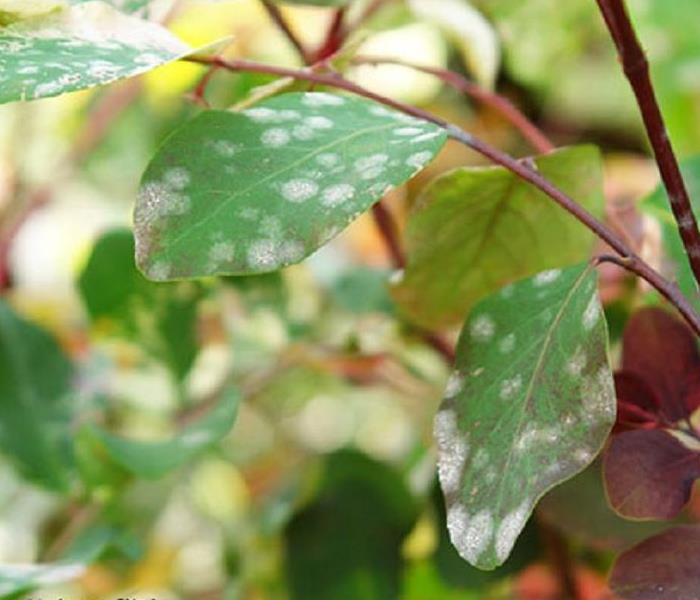 Powdery Mildew
Powdery Mildew
While there are many differences between the two fungi, mold and mildew both develop and thrive in moist conditions. A leaking roof, a window that doesn’t seal properly, and a basement with water damage caused by a broken pipe can all lead to the growth of mildew and mold. In order to reduce the risk of health effects and damage to building materials, mildew and mold in the home or a business need immediate mold remediation. Continue reading to learn more about the differences between mold and mildew, and the danger both may present to your home or business.
Mildew vs Mold
Plain and simple, mildew and mold are fungi. Fungi can live in many different types of habitats such as in soil, on vegetation, and on surfaces exposed to moist conditions like a wall or ceiling after flood damage. Fungi reproduce by spores and quickly can spread.
What is mildew? Mildew is mold in its early stage and often the term is used interchangeably with the word mold. That whitish-gray, powdery substance sometimes seen on the leaves of a plant is mildew. Mildew is a surface fungi that grows on organic material like plants and food as well as wood or fibrous items like:
- Drywall
- Insulation
- Cardboard/paperboard
- Wallpaper
- Fabric
How is it different from Mold? Mold ranges in color from green to gray, brownish and black. It may appear fuzzy, flat or even slimy. Green slimy mold may develop in the damp, shady areas of decks and even vinyl siding, while indoors, mold can develop on grout, tile and other surfaces found in and around bathrooms and other areas with high humidity and inadequate ventilation.
Common Mold Types
Although the number of mold species that can live indoors exceeds 10,000, the most household molds belong to one of the following five types:
- Alternaria grows on walls, in showers, around windows, under sinks and in various other damp places. It is often found in buildings that have suffered some kind of water damage. Alternaria mold can appear black, grey, or dark brown and has a wooly or down-like texture. Prolonged exposure to this kind of fungi can cause allergic reactions and asthma attacks;
- Aspergillus is the most common type of mold found indoors. It can look grey, brown, yellow, green, white, or black. Aspergillus mold usually grows on walls, insulation, paper products, and clothing. It can causes allergic reactions and respiratory infections, as well as inflammation of the lungs in people with weak immune systems;
- Unlike many other molds, Cladosporium can grow in cool areas. It usually appears on fabrics, such as carpets or curtains, and on wood surfaces, like cabinets and floorboards. It has a characteristic black or olive-green color and can cause a variety of respiratory problems;
- Penicillium can be found on various materials that have been in contact with water, including carpeting, wallpaper, insulation, and mattresses. It looks blue or green and produces strong musty odors. Penicillium spores spread very easily and often result in allergic reactions;
- Stachybotrys chartarum, often referred to as “black mold” because of its color, is the most dangerous kind of household mold – it produces toxic compounds called mycotoxins that can cause severe health problems, such as allergic symptoms, breathing problems, asthma attacks, chronic sinus infections, fatigue, and depression. The toxic black mold has a characteristic musty odor and usually grows in areas that are constantly damp – around leaky pipes, inside air conditioning ducts where there is a lot of condensation, etc.
Differences in the Effects of Mold and Mildew
Both mold and mildew need to be taken care of in a quick and efficient manner as they can cause a lot of trouble over time:
- Mildew usually affects plants and crops. If it develops indoors, however, it can also pose health risks. When inhaled, mildew spores cause coughing, headache, sore throat, and respiratory problems;
- Mold can result in considerable structural damage when left unattended for a long time. Prolonged exposure can cause a variety of health problems, depending on the strain of mold. Common health effects of mold include various allergic reactions (sneezing, skin irritations, irritation of the eyes and throat, nasal congestion, etc.), respiratory problems (difficulty breathing, coughing, pneumonia, asthma attacks), heart problems, migraines, inflammation and pain in the joints, dizziness, depression, and extreme fatigue. The mycotoxins produced by black mold are particularly harmful and may have severe long-term health effects, especially in younger kids and individuals with weak immune systems.
How to Prevent Mold and Mildew
The most efficient way to prevent mold and mildew in your home is to keep all the areas dry and moisture-free. Maintain a humidity level of about 40-50% inside the house (a dehumidifier provides the most advantageous solution for ensuring appropriate indoor humidity), have your heating and cooling systems regularly inspected, keep air ducts clean and in good condition, ensure good air circulation inside the premises, fix any leaks in the bathroom, kitchen or other areas, etc. Remove any mildew-affected plants and weeds as soon as you notice them in order to prevent mildew infestation.
How to Clean Mold and Mildew
Mildew is a surface fungus that can be efficiently treated with a commercially available cleaner and a scrubbing brush. Just make sure you work in a well-ventilated area and wear a facial mask to prevent inhaling mildew spores, as well as to avoid breathing in fumes given off by the cleaning product you use. It is also advisable to put on rubber gloves in order to protect your hands both from the mildew and from the cleaning agent. Clean all the surrounding areas carefully as well, to ensure that all the fungi have been successfully removed.
Mold, on the other hand, attaches to the affected materials with microscopic filaments that penetrate beneath the surface. The mold spores spread very easily and can survive in extreme conditions, so they can quickly affect large areas of your property and result in permanent damage. Moreover, despite its characteristic musty smell, mold is only visible to the eye when the colonies start growing, so early detection and prevention is very difficult. Worst of all, mold can have a very negative impact on your health, so DIY removal attempts are not recommendable. Besides, DIY remedies are rarely efficient because the fungus usually grows in areas that are very difficult to access and to treat
The Need for Mold Remediation
Mold and mildew, if ignored, can cause long-term health issues and physical damage to a home or business. Mold found anywhere in a building, such as behind drywall, on insulation, around windows and along basement walls has developed because there is a moisture problem. To avoid further damage, it’s essential to locate and correct the source of the moisture and then remove all traces of mold. The safest and most efficient way to get rid of a mold problem is to call a mold remediation company. An experienced professional will come to your home to assess the situation and determine the type of mold or mildew in your property, as well as the extent of the damage. Then, the most appropriate actions will be taken to remove the harmful fungi and prevent its appearance in the near future. The experts will help ensure not only the safety of your living environment, but also your peace of mind.
Follow These Mold Safety Tips If You Suspect Mold in Beatrice, NE
10/5/2016 (Permalink)
Beatrice, Nebraska residents, follow these mold safety tips if you suspect mold.
If you see visible mold, do not disturb it. You can inadvertently spread the mold infestation throughout your home. When mold is disturbed, the mold can release microscopic mold spores which become airborne and can circulate inside your home.
What to Do:
- Stay out of affected areas.
- Turn off the HVAC system and fans.
- Contact SERVPRO of Lincoln East for mold remediation services.
What Not to Do:
- Don’t touch or disturb the mold.
- Don’t blow air across any surfaces with visible or suspected mold growth.
- Don’t attempt to dry the area yourself.
- Don’t spray bleach or other disinfectants on the mold.
About Our Mold Remediation Services
SERVPRO of Lincoln East specializes in mold cleanup and restoration, in fact, it’s a cornerstone of our business. Our crews are highly trained restoration professionals that use specialized equipment and techniques to properly remediate your mold problem quickly and safely.
If You See Signs of Mold, Call Us Today – 402-466-4004
Does Your Lincoln, NE Home Have A Mold Problem?
8/30/2016 (Permalink)
Microscopic mold spores naturally occur almost everywhere, both outdoors and indoors. This makes it impossible to remove all mold from a home or business. Therefore, mold remediation reduces the mold spore count back to its natural or baseline level. Some restoration businesses advertise “mold removal” and even guarantee to remove all mold, which is a fallacy. Consider the following mold facts:
- Mold is present almost everywhere, indoors and outdoors.
- Mold spores are microscopic and float along in the air and may enter your home through windows, doors, or AC/heating systems or even hitch a ride indoors on your clothing or a pet.
- Mold spores thrive on moisture. Mold spores can quickly grow into colonies when exposed to water. These colonies may produce allergens and irritants.
- Before mold remediation can begin, any sources of water or moisture must be addressed. Otherwise, the mold may return.
- Mold often produces a strong, musty odor and can lead you to possible mold problem areas.
- Even higher-than-normal indoor humidity can support mold growth. Keep indoor humidity below 45 percent.
If your home or business has a mold problem, we can inspect and assess your property and use our specialized training, equipment, and expertise to remediate your mold infestation.
Are Condensation and Mold Forming In or Around Your A/C Unit?
8/12/2016 (Permalink)
Across Lincoln, NE, we have experienced consistently high heat and humidity levels. This has wreaked havoc on the propensity of air handlers to keep up with customers’ demands. While a little dampness on a unit or a duct may sound harmless, the resulting effects on your insulation, drywall, and other building materials may be detrimental. Often times these issues go unnoticed and when they are discovered, mold growth is usually an issue. Please follow a few of these easy rules to make sure that you don’t end up with a larger problem.
- Inspect HVAC units often. We aren’t just talking about taking a peak up at your vents every once in a while, take a ladder and go inspect your return and handler frequently. Note any discoloration, corrosion or standing water. Look for water staining around the area that may have been caused by condensation or faulty components. Also make sure the condensation drain line is open and flowing into a drain that is working.
- Get Your AC Unit Serviced. Once a year, your unit should be serviced by an HVAC professional. They will be able to help identify any potential issues that you may encounter and curb water damage in your home or business.
- Get a moisture inspection using a hygrometer. Testing your indoor air quality can often times be as easy as knowing the indoor relative humidity and temperature. Any sharp fluctuations in relative humidity are a large indication that there may be a problem with your system. Regardless of where you set your thermostat, if you have relative humidity levels higher than 60% you are putting your home or business at risk of secondary damage including mold or condensation.
- Watch windows and vents. Mildew and condensation should not build up on these areas if your HVAC unit is properly sized for the area in which it is trying to condition. If you are seeing discoloration around your vents or noticing mold buildup on window caulking you may need to call a mold remediation specialist.
- Don’t ignore your senses. If you walk into your home and smell an earthy or musky odor you may have a mold issue. If you walk into your business and your skin instantly feels sticky and wet, your AC system may not be operating properly. If you see staining or discoloration that wasn’t seen before, don’t turn a blind eye. Using common sense and listening to your instincts are often the best ways to prevent further damage.
Got Mold? What You Need to Know
6/6/2016 (Permalink)
Due to all the moisture that we have had in Southeast Nebraska, mold could be growing in your home!
What are molds and where do they grow?
Molds, like most fungi, break down plant and animal matter in the environment. They can grow almost anywhere there is moisture and organic material such as in soil, on foods and plants, and in people's homes. To reproduce, molds release spores, which can spread through air, water, or on animals.
What should I do to prevent mold growth in my home?
The key to preventing mold growth is to identify and control moisture and water problems. Mold spores are everywhere, including your home, and they can grow on any surface that has sufficient moisture.
Common sources of moisture are:
- Roof leaks
- Indoor plumbing leaks
- Outdoor drainage problems
- Damp basements and crawl spaces
- Steam from the bathroom or kitchen
- Condensation on cool surfaces
- Humidifiers
- Wet clothes drying inside the home
- A clothes dryer venting indoors
- Poor or improper ventilation of heating and cooking appliances
- Flooding
How do I know if I have a mold problem?
You can usually see or smell a mold problem. Mold can appear as slightly fuzzy, discolored, or slimy patches that increase in size as they grow. Most molds produce musty odors that are the first indication of a problem. Mold can grow anywhere there is adequate moisture or a water problem. The best way to find mold is to look for signs of mold growth, water staining, warping, or to follow your nose to the source of the odor. It may be necessary to look behind and underneath surfaces, such as carpets, wallpaper, cabinets, and walls. There are some areas of the home that are always susceptible to mold growth and should be part of routine cleaning to control mold growth. These are:
- Bathrooms especially shower stalls, bathroom tiles, and shower curtains
- Window moldings
- The seal on the refrigerator door
- Surfaces on and around air conditioners
How do I get rid of mold in my home?
PLEASE READ AND FOLLOW ALL LABEL INSTRUCTIONS FOR ANY CLEANING PRODUCTS
- The first step to mold cleanup is to control the moisture problem. The source of the water or dampness must be identified and corrected.
- Porous materials with extensive mold growth should be discarded (e.g., drywall, carpeting, paper, and ceiling tiles).
- All wet materials that can't be cleaned and dried thoroughly, should be discarded.
- Hard surfaces that are not decayed (rotten) can be cleaned. Small areas can be cleaned with detergent and water. An experienced remediation company should do the work if it is a large (greater than 10 square feet) mold problem or if you are highly sensitive to mold. Rubber gloves and an N95 dust mask are recommended for jobs other than routine cleaning.
- In areas where it is impractical to eliminate the moisture source, detergemt can be used to keep mold growth under control. In areas that can be kept dry, cleaning should not be necessary, as mold cannot grow in the absence of moisture. When using any cleaner, ensure that enough fresh air is available to prevent eye, nose, or throat irritation.
- Inspect the area for signs of moisture and new mold growth. These may indicate the need for further repairs or material removal. High moisture areas like bathrooms need extra attention to prevent excessive moisture and water problems from causing mold growth.
More information is available at epa.gov/mold





 24/7 Emergency Service
24/7 Emergency Service

